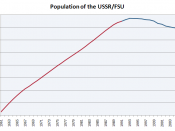Slide Presentation: Real Life in 21st-Century Ukraine OBJECTIVE: Students will understand the major political, economic, and social trends of Ukraine's transition from a republic in the USSR to an independent country. Students will have a basic understanding of what everyday life is like for the average Ukrainian in 2000.
Political: change from communism to democracy; change from part of the USSR to independent country; increased political freedoms Economic: move away from a planned economy (communism) to something closer to free-market capitalism; increase in people living in poverty; average salaries compared to the average cost of living; loss of free universal health care and education; loss of guaranteed employment Social: decreasing population, decreasing standard of living, falling life expectancy; increasing social problems; increased intellectual freedom; increased possibility to communicate with the outside world and foreigners; increased and decreased possibilities to travel QUESTIONS FOR DISCUSSION: In what ways has Ukraine changed since 1991? In what ways has life changed for Ukrainians since 1991? How has life changed differently for different kinds of people? Who are these different people? Why have they had different experiences? What are the good and bad sides of the changes which have occurred in Ukraine since 1991? What have people gained? What have they lost? Who might be happy with the new situation in Ukraine, and why? Who might be unhappy with the new situation in Ukraine, and why? What do you think: How important is economic security to you? How important is freedom to you? Real Life in 21st-Century Ukraine 1.
INTRODUCTION: Ukraine's transition from a republic in the USSR to an independent country.
A. THE USSR: The USSR consisted of 15 union republics and 100 different ethnic groups, who spoke 80 different languages. It extended through 11 of the world's 24 time zones and included more...


